Homework #2 Chapter 4 Homework Answers
PDF version
Chapter 4 Homework AnswersChapter 4: Longwave Radiation Spectrum
Exercise 4.1: Methane
Methane has a current concentration of 1.7 ppm in the atmosphere and is doubling at a faster rate than CO2.
Part (a)
Would an additional 10 ppm of methane in the atmosphere have a larger or smaller impact on the outgoing IR flux than an additional 10 ppm of CO2 at current concentrations?
Answer: I ran MODTRAN three times.
- One run was a baseline, which used the current concentrations of CO2 and CH4.
- Then I ran MODTRAN with the CO2 concentration increased by 10 ppm.
- Finally, I ran it a third time with the baseline value for CO2, but with CH4 increased by 10 ppm.
For the baseline run, the intensity of outgoing longwave light was 298. Watts per square meter. Increasing CO2 by 10 ppm decreased the outgoing longwave light by 0.1 W/m2, to 298. and increasing CH4 by 10 ppm decreased the outgoing longwave light by 3.1 W/m2 to 295.. The change in Iout for methane is is around 25. times as much as for CO2.
The difference is because absorption for CO2 is strongly saturated, but the absorption for CH4 is not saturated. Another way to think about this is that a 10 ppm increase in CO2 increases the amount of CO2 by 2.% and a 10 ppm increase in CH4 increases the amount of CH4 by 590.%.
Part (b)
Where in the spectrum does methane absorb? What concentration does it take to begin to saturate the absorption in this band? Explain what you are looking at to judge when the gas is saturated.
Answer: The plots below show the MODTRAN spectrum with all gases set to zero except methane. Methane absorbs most strongly around 1300 wavenumbers.
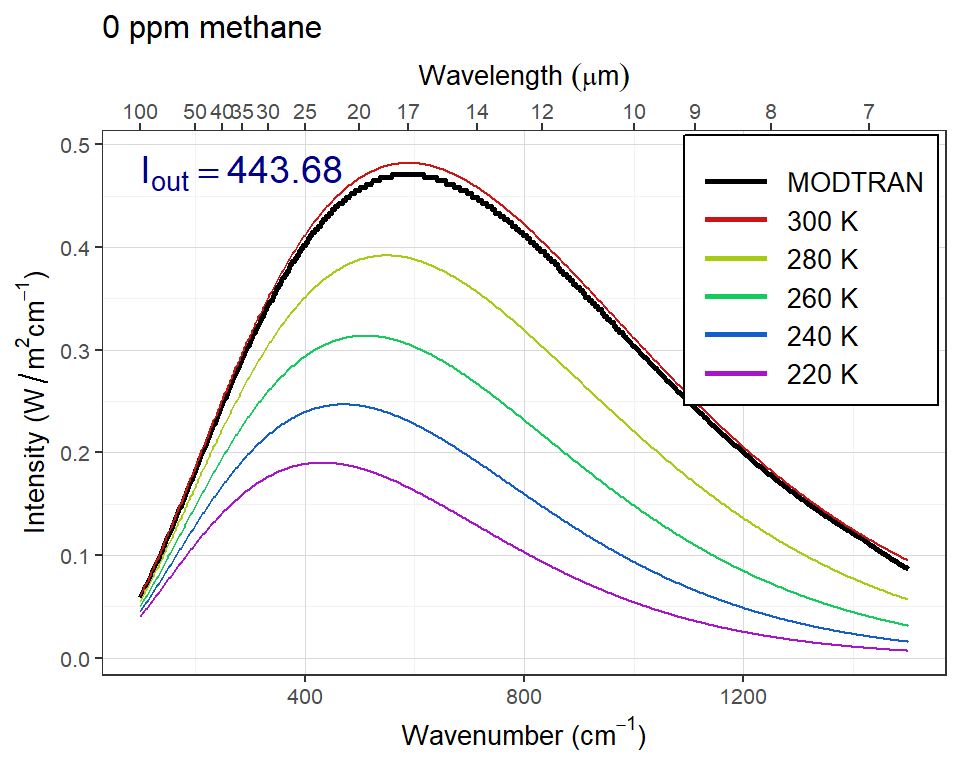
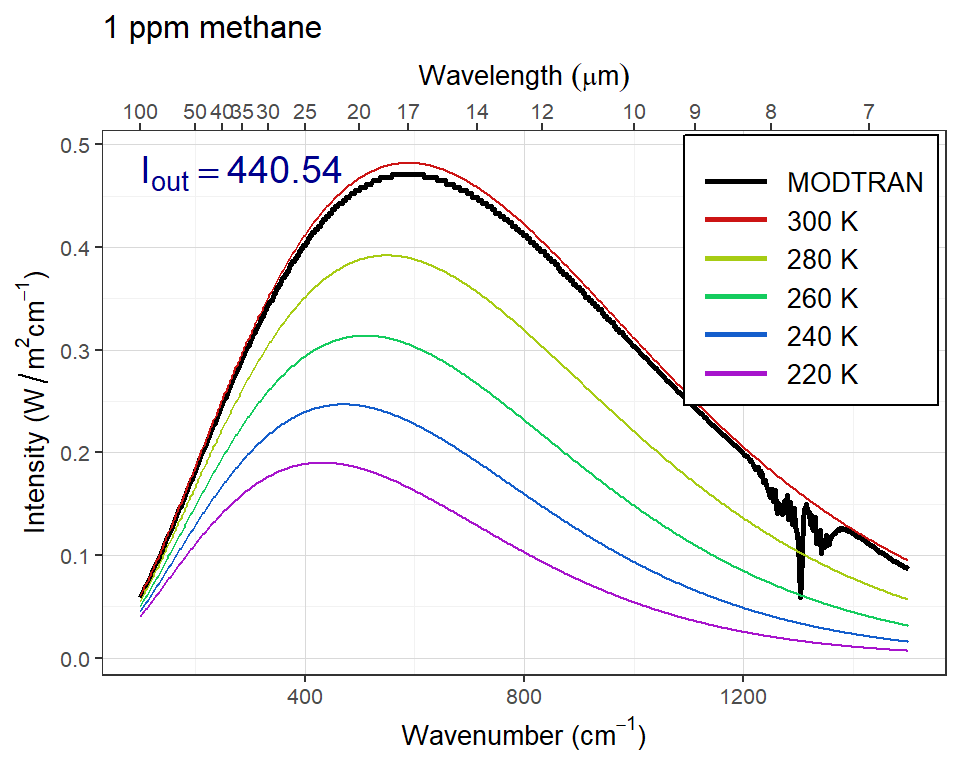


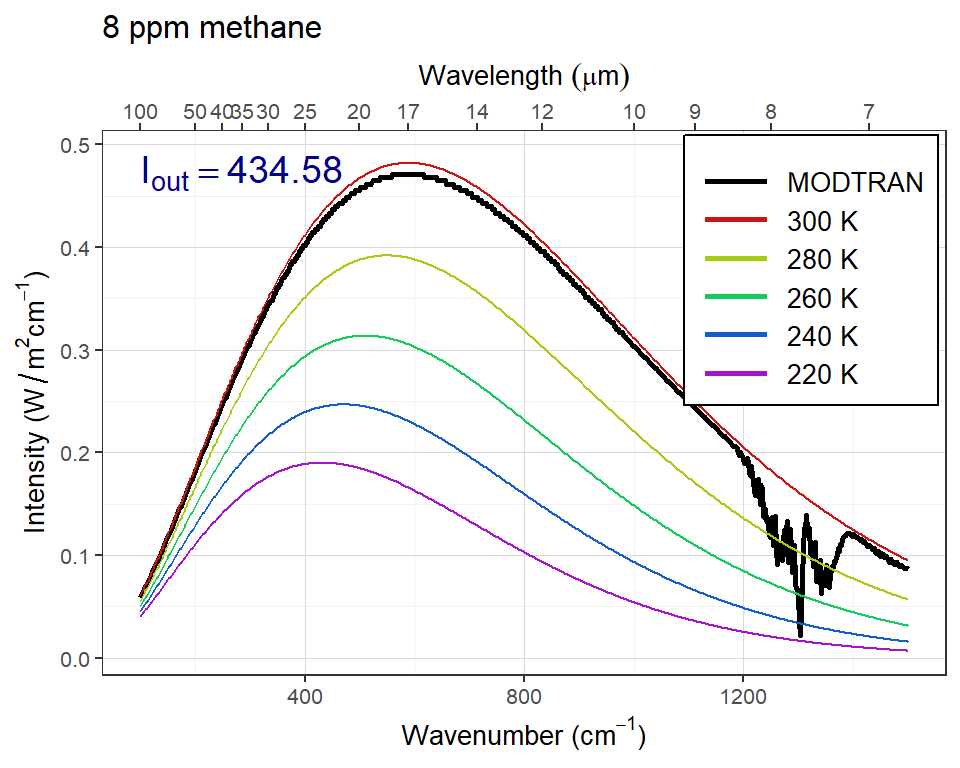


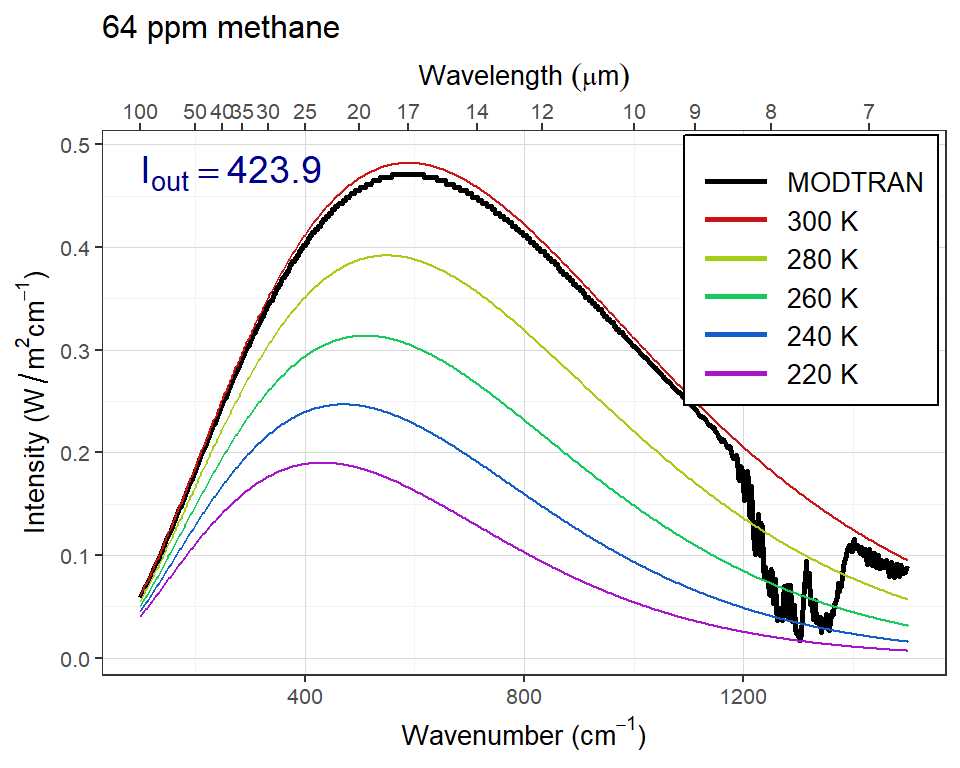

As we increase the methane concentration, the big spike around 1300 wavenumbers gets bigger until it bottoms out on the purple line. This happens somewhere around 8, 16, or 32 ppm, so any of those anwers would be correct. But the spectrum is complicated and so is its saturation, so other answers are plausible if they are supported by sound reasoning.
Part (c)
Would a doubling of methane have as great an impact on the heat balance as a doubling of CO2?
Answer: The baseline value for Iout is 298. W/m2. If we double CO2, it drops to 295. W/m2, a decrease of 3. W/m2, and if we double CH4, it drops to 298. W/m2, a decrease of 0.9 W/m2. Doubling CO2 has the larger effect because there is a lot more CO2 in the atmosphere and that is more important than how saturated its absorption is.
You can see this if you look at the plots below. Notice that the effect of doubling CO2 isn’t to make the big CO2 absorption feature get deeper, but to make it wider. You can see this if you compare the baseline to the doubled CO2 spectrum where the spectrum crosses the 240 K blackbody curve near 600 cm-1 and around 750 cm-1. Compare this to the very small change in the methane spike near 1300 cm-1 (you have to look very carefully at the doubled methane spectrum to notice this).



Part (d)
What is the “equivalent CO2” of doubling atmospheric methane? That is to say, how many ppm of CO2 would lead to the same change in outgoing IR radiation energy flux as doubling methane? What is the ratio of ppm CO2 change to ppm methane change?
Answer: When we double CH4, Iout is 297.6 W/m2. We need to adjust CO2 to produce the same Iout with the defailt value of 1.7 ppm CH4. After some trial and error, this turns out to be about 480 ppm, which has Iout = 297.6. The ratio of to is
Exercise 4.3: Water vapor
Our theory of climate presumes that an increase in the temperature at ground level will lead to an increase in the outgoing IR energy flux at the top of the atmosphere.
Part (a)
How much extra outgoing IR would you get by raising the temperature of the ground by 5°C? What effect does the ground temperature have on the shape of the outgoing IR spectrum and why?
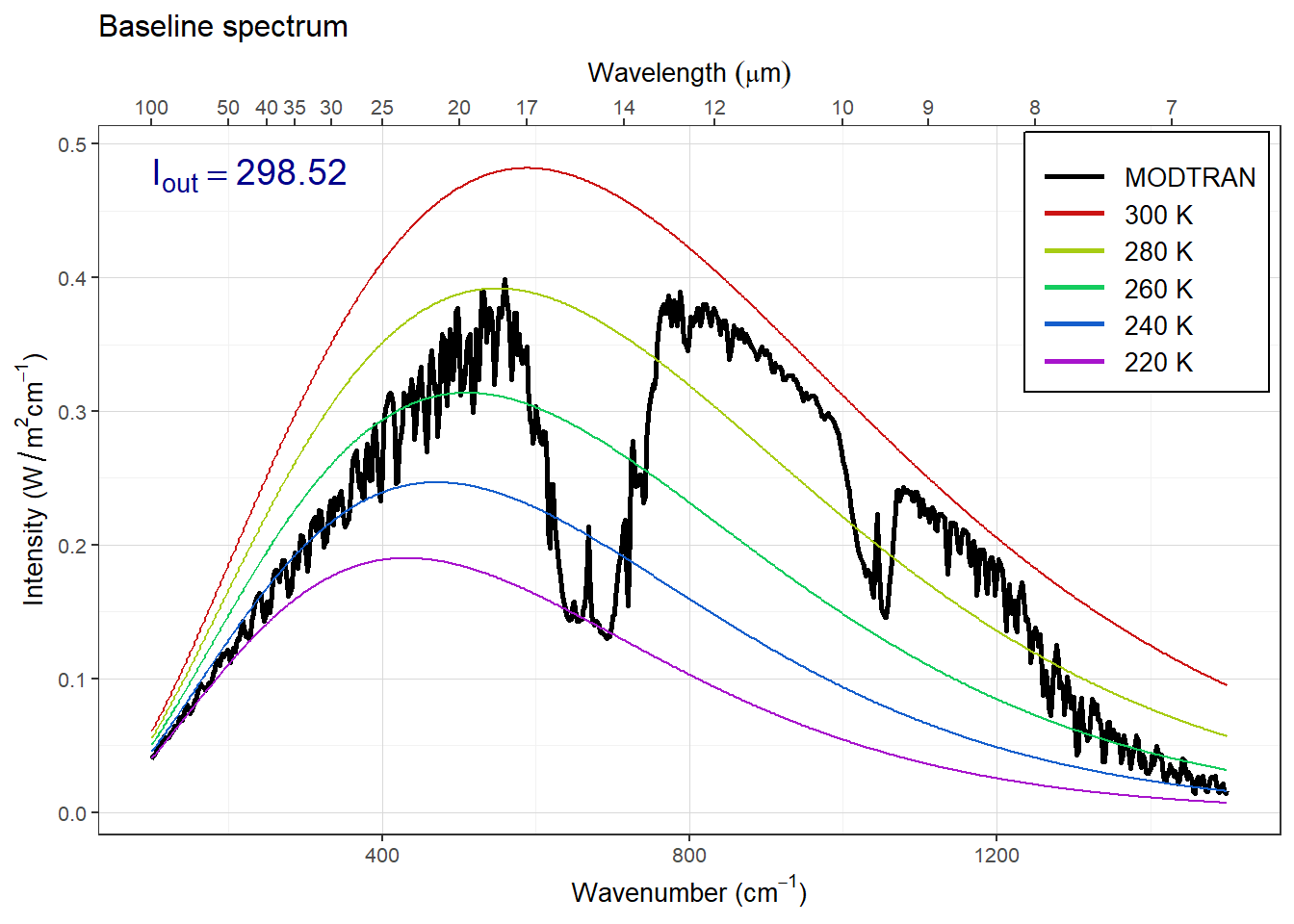

Answer: Raising the ground temperature raises the entire spectrum, and the intensity of outgoing longwave radiation increases from 298.5 W/m2 to 321.2 W/m2: a change of 22.7 W/m2.
Part (b)
More water can evaporate into warm air than into cool air. Change the model settings to hold the water vapor at constant relative humidity rather than constant vapor pressure (the default), calculate the change in outgoing IR energy flux for a 5°C temperature increase. Is it higher or lower? Does water vapor make the Earth more sensitive to CO2 increases or less sensitive?


Answer: Raising the ground temperature with constant relative humidity raises the intensity of outgoing longwave radiation from 298.5 W/m2 to 312.4 W/m2: a change of 13.9 W/m2.
This is a smaller change than when we raised the surface temperature with constant vapor pressure.
This means that compensating for a change in CO2 would require a bigger change in temperature with fixed relative humidity, so the climate is more sensitive to changes in CO2 when relative humidity is fixed.
Part (c)
Now see this effect in another way.
Starting from the default base case, record the total outgoing IR flux.
Increase CO2 to 550 ppm. The temperature in the model stays the same (that’s how the model is written), but the outgoing IR flux goes down.
Using constant water vapor pressure, adjust the temperature offset until you get the original IR flux back again. Record the change in temperature.
Now repeat the calculation, but holding the relative humidity fixed instead of the water vapor pressure. Does the increase in CO2 drive a bigger or smaller teemperature change?
Answer: In the baseline case, Iout = 298.5 W/m2. When we double CO2 with constant water vapor pressure, Iout drops to 297.0 W/m2 and we have to raise the ground temperature by 0.345 K to bring Iout back to 298.5 W/m2.
When we double CO2 with constant water relative humidity, Iout drops to 297.0 W/m2 and we have to raise the ground temperature by 0.550 K to bring Iout back to 298.5 W/m2.
Allowing water vapor to respond to changes in temperature means that CO2 causes more warming.
Notice that there is no difference between holding vapor pressure constant and holding relative humidity constant until the temperature changes.
